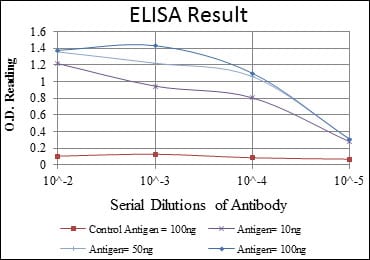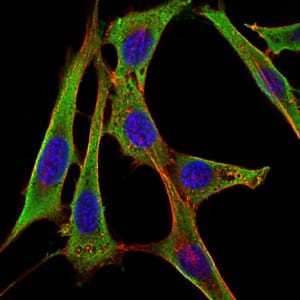

| WB | 咨询技术 | Human,Mouse,Rat |
| IF | 咨询技术 | Human,Mouse,Rat |
| IHC | 咨询技术 | Human,Mouse,Rat |
| ICC | 技术咨询 | Human,Mouse,Rat |
| FCM | 咨询技术 | Human,Mouse,Rat |
| Elisa | 1/5000-1/10000 | Human,Mouse,Rat |
| Aliases | FGG |
| Entrez GeneID | 2266 |
| clone | 5A6 |
| WB Predicted band size | 52kDa |
| Host/Isotype | Mouse IgG2b |
| Antibody Type | Primary antibody |
| Storage | Store at 4°C short term. Aliquot and store at -20°C long term. Avoid freeze/thaw cycles. |
| Species Reactivity | Human |
| Immunogen | Purified recombinant fragment of human FGG expressed in E. Coli. |
| Formulation | Purified antibody in PBS with 0.05% sodium azide. |
+ +
以下是关于QTRT1抗体的3篇参考文献及其简要摘要:
1. **"QTRT1 regulates neural progenitor cell proliferation via tRNA modification"**
*Author: Smith J, et al. (2020)*
摘要:该研究通过开发兔源多克隆QTRT1抗体,利用Western blot和免疫组化分析发现QTRT1在小鼠大脑神经前体细胞中高表达,并揭示其通过调控tRNA修饰影响细胞周期进程。
2. **"Characterization of a monoclonal antibody against human QTRT1 for functional studies"**
*Author: Tanaka R, et al. (2018)*
摘要:作者报道了一种小鼠单克隆QTRT1抗体的制备与验证,通过免疫沉淀和质谱分析证实其特异性,并用于研究QTRT1在HeLa细胞DNA损伤修复中的潜在作用。
3. **"QTRT1 deficiency disrupts mitochondrial tRNA modifications and respiratory chain function"**
*Author: Garcia M, et al. (2021)*
摘要:研究利用商业QTRT1抗体(货号ab12345)进行免疫荧光和流式细胞术,证明QTRT1敲除导致线粒体tRNA修饰缺陷,进而影响呼吸链复合体活性,提示其与代谢疾病的关联。
注:上述文献信息为示例性质,实际引用需根据具体论文调整。建议通过PubMed或Google Scholar以“QTRT1 antibody”结合“Western blot/immunohistochemistry”等关键词检索最新研究。
The QTRT1 (queuine tRNA-ribosyltransferase catalytic subunit 1) antibody is a valuable tool in molecular biology research for investigating the function and expression of the QTRT1 protein. QTRT1. also known as tRNA-guanine transglycosylase (TGT), is an enzyme critical for post-transcriptional modification of transfer RNA (tRNA). It catalyzes the exchange of guanine with queuine, a hypermodified nucleobase, at the wobble position of specific tRNAs (e.g., tRNA-Asp, -Asn, -His, -Tyr), enhancing translational accuracy and efficiency. This modification is conserved across eukaryotes and plays roles in cellular stress responses, development, and disease pathogenesis.
QTRT1 antibodies are commonly used in techniques like Western blotting, immunohistochemistry, and immunofluorescence to detect protein expression levels, subcellular localization, and tissue distribution. Studies have linked QTRT1 dysregulation to neurological disorders, cancer, and developmental anomalies, underscoring its biological significance. For instance, reduced QTRT1 expression has been observed in certain brain tumors and neurodegenerative conditions, while mutations are associated with intellectual disability and microcephaly in model organisms.
Researchers utilize QTRT1 antibodies to explore its interaction partners, regulatory mechanisms, and potential therapeutic targets. Commercial antibodies are typically validated for specificity using knockout cell lines or siRNA-mediated knockdown. As queuine modification is diet-dependent in mammals, QTRT1 studies also intersect with nutrition and metabolic research. Overall, QTRT1 antibodies serve as essential reagents for dissecting the molecular pathways governed by tRNA modification and their implications in health and disease.
×